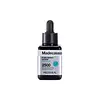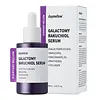What's inside
What's inside
 Key Ingredients
Key Ingredients

 Benefits
Benefits

 Concerns
Concerns

 Ingredients Side-by-side
Ingredients Side-by-side

Water
Skin ConditioningPropanediol
SolventDipropylene Glycol
HumectantNiacinamide
Smoothing1,2-Hexanediol
Skin ConditioningButyrospermum Parkii Butter
Skin ConditioningPanthenol
Skin ConditioningHydrolyzed Sponge
Skin ConditioningDiglycerin
HumectantHydroxyacetophenone
AntioxidantAmmonium Acryloyldimethyltaurate/Vp Copolymer
Glyceryl Glucoside
HumectantAcrylates/C10-30 Alkyl Acrylate Crosspolymer
Emulsion StabilisingArginine
MaskingPolyglyceryl-10 Laurate
Skin ConditioningHydrogenated Lecithin
EmulsifyingPolyglyceryl-10 Stearate
Skin ConditioningButylene Glycol
HumectantAdenosine
Skin ConditioningXanthan Gum
EmulsifyingMadecassoside
AntioxidantTrisodium Ethylenediamine Disuccinate
Pyrus Communis Fruit Extract
Skin ConditioningJuniperus Virginiana Oil
MaskingRosa Damascena Flower Water
MaskingGlucose
HumectantIris Florentina Root Extract
MaskingSimmondsia Chinensis Seed Oil
EmollientCucumis Melo Fruit Extract
Skin ConditioningPogostemon Cablin Leaf Oil
MaskingCentella Asiatica Extract
CleansingHedera Helix Leaf/Stem Extract
AntimicrobialFicus Carica Fruit Extract
HumectantCyperus Rotundus Root Extract
Skin ConditioningArtemisia Vulgaris Oil
PerfumingRosmarinus Officinalis Leaf Oil
MaskingCeramide NP
Skin ConditioningDiospyros Kaki Leaf Extract
Skin ProtectingEthylhexylglycerin
Skin ConditioningVitis Vinifera Fruit Extract
Skin ConditioningCarthamus Tinctorius Flower Extract
Skin ConditioningCoffea Arabica Seed Extract
MaskingPolygonum Cuspidatum Root Extract
AntioxidantCamellia Sinensis Leaf Extract
AntimicrobialCastanea Crenata Shell Extract
Skin ConditioningZanthoxylum Piperitum Fruit Extract
Skin ConditioningCitric Acid
BufferingWater, Propanediol, Dipropylene Glycol, Niacinamide, 1,2-Hexanediol, Butyrospermum Parkii Butter, Panthenol, Hydrolyzed Sponge, Diglycerin, Hydroxyacetophenone, Ammonium Acryloyldimethyltaurate/Vp Copolymer, Glyceryl Glucoside, Acrylates/C10-30 Alkyl Acrylate Crosspolymer, Arginine, Polyglyceryl-10 Laurate, Hydrogenated Lecithin, Polyglyceryl-10 Stearate, Butylene Glycol, Adenosine, Xanthan Gum, Madecassoside, Trisodium Ethylenediamine Disuccinate, Pyrus Communis Fruit Extract, Juniperus Virginiana Oil, Rosa Damascena Flower Water, Glucose, Iris Florentina Root Extract, Simmondsia Chinensis Seed Oil, Cucumis Melo Fruit Extract, Pogostemon Cablin Leaf Oil, Centella Asiatica Extract, Hedera Helix Leaf/Stem Extract, Ficus Carica Fruit Extract, Cyperus Rotundus Root Extract, Artemisia Vulgaris Oil, Rosmarinus Officinalis Leaf Oil, Ceramide NP, Diospyros Kaki Leaf Extract, Ethylhexylglycerin, Vitis Vinifera Fruit Extract, Carthamus Tinctorius Flower Extract, Coffea Arabica Seed Extract, Polygonum Cuspidatum Root Extract, Camellia Sinensis Leaf Extract, Castanea Crenata Shell Extract, Zanthoxylum Piperitum Fruit Extract, Citric Acid
Galactomyces Ferment Filtrate 95%
HumectantNiacinamide
SmoothingBakuchiol
AntimicrobialPanthenol
Skin ConditioningCollagen
Moisturising1,2-Hexanediol
Skin ConditioningHydroxyacetophenone
AntioxidantSimmondsia Chinensis Seed Oil
EmollientTocopheryl Acetate
AntioxidantPropanediol
SolventButylene Glycol
HumectantCentella Asiatica Extract
CleansingCarbomer
Emulsion StabilisingAlgin
MaskingCeramide NP
Skin ConditioningCannabis Sativa Seed Extract
EmollientAdenosine
Skin ConditioningGeranium Maculatum Oil
MaskingGalactomyces Ferment Filtrate 95%, Niacinamide, Bakuchiol, Panthenol, Collagen, 1,2-Hexanediol, Hydroxyacetophenone, Simmondsia Chinensis Seed Oil, Tocopheryl Acetate, Propanediol, Butylene Glycol, Centella Asiatica Extract, Carbomer, Algin, Ceramide NP, Cannabis Sativa Seed Extract, Adenosine, Geranium Maculatum Oil
Ingredients Explained
These ingredients are found in both products.
Ingredients higher up in an ingredient list are typically present in a larger amount.
1,2-Hexanediol is a synthetic liquid and another multi-functional powerhouse.
It is a:
- Humectant, drawing moisture into the skin
- Emollient, helping to soften skin
- Solvent, dispersing and stabilizing formulas
- Preservative booster, enhancing the antimicrobial activity of other preservatives
Adenosine is in every living organism. It is one of four components in nucleic acids that helps store our DNA.
Adenosine has many benefits when used. These benefits include hydrating the skin, smoothing skin, and reducing wrinkles. Once applied, adenosine increases collagen production. It also helps with improving firmness and tissue repair.
Studies have found adenosine may also help with wound healing.
In skincare products, Adenosine is usually derived from yeast.
Learn more about AdenosineButylene Glycol (or BG) is used within cosmetic products for a few different reasons:
Overall, Butylene Glycol is a safe and well-rounded ingredient that works well with other ingredients.
Though this ingredient works well with most skin types, some people with sensitive skin may experience a reaction such as allergic rashes, closed comedones, or itchiness.
Learn more about Butylene GlycolCentella Asiatica Extract (Centella) is derived from an herb native to Southeast Asia. It is famous for its anti-inflammatory and soothing properties.
Centella is rich in antioxidants and amino acids, such as Madecassic Acid and Asiaticoside.
Studies show the compounds in centella help with:
The combination of all these properties makes centella effective at soothing, hydrating, and protecting the skin.
Other great components of centella include Vitamin A, vitamin C, several B vitamins, and Asiatic Acid.
Fun fact: Centella has been used as a medicine and in food for many centuries. As a medicine, it is used to treat burns, scratches, and wounds.
Learn more about Centella Asiatica ExtractCeramide NP is a type of ceramide.
Ceramides are intercellular lipids naturally found in our skin that bonds dead skin cells together to create a barrier. They are known for their ability to hold water and thus are a great ingredient for dry skin.
Ceramides are an important building block for our skin barrier. A stronger barrier helps the skin look more firm and hydrated. By bolstering the skin ceramides act as a barrier against irritating ingredients. This can help with inflammation as well.
If you would like to eat ceramides, sweet potatoes contain a small amount.
Read more about other common types of ceramides here:
Ceramide AP
Ceramide EOP
Hydroxyacetophenone is antioxidant with skin conditioning and soothing properties. It also boosts the efficiency of preservatives.
This ingredient is not irritating or sensitizing.
Niacinamide is a multitasking form of vitamin B3 that strengthens the skin barrier, reduces pores and dark spots, regulates oil, and improves signs of aging.
And the best part? It's gentle and well-tolerated by most skin types, including sensitive and reactive skin.
You might have heard of "niacin flush", or the reddening of skin that causes itchiness. Niacinamide has not been found to cause this.
In very rare cases, some individuals may not be able to tolerate niacinamide at all or experience an allergic reaction to it.
If you are experiencing flaking, irritation, and dryness with this ingredient, be sure to double check all your products as this ingredient can be found in all categories of skincare.
When incorporating niacinamide into your routine, look out for concentration amounts. Typically, 5% niacinamide provides benefits such as fading dark spots. However, if you have sensitive skin, it is better to begin with a smaller concentration.
When you apply niacinamide to your skin, your body converts it into nicotinamide adenine dinucleotide (NAD). NAD is an essential coenzyme that is already found in your cells as "fuel" and powers countless biological processes.
In your skin, NAD helps repair cell damage, produce new healthy cells, support collagen production, strengthen the skin barrier, and fight environmental stressors (like UV and pollution).
Our natural NAD levels start to decline with age, leading to slower skin repair, visible aging, and a weaker skin barrier. By providing your skin niacinamide, you're recharging your skin's NAD levels. This leads to stronger, healthier, and younger looking skin.
Another name for vitamin B3 is nicotinamide. This vitamin is water-soluble and our bodies don't store it. We obtain Vitamin B3 from either food or skincare. Meat, fish, wheat, yeast, and leafy greens contain vitamin B3.
The type of niacinamide used in skincare is synthetically created.
Learn more about NiacinamidePanthenol is a common ingredient that helps hydrate and soothe the skin. It is found naturally in our skin and hair.
There are two forms of panthenol: D and L.
D-panthenol is also known as dexpanthenol. Most cosmetics use dexpanthenol or a mixture of D and L-panthenol.
Panthenol is famous due to its ability to go deeper into the skin's layers. Using this ingredient has numerous pros (and no cons):
Like hyaluronic acid, panthenol is a humectant. Humectants are able to bind and hold large amounts of water to keep skin hydrated.
This ingredient works well for wound healing. It works by increasing tissue in the wound and helps close open wounds.
Once oxidized, panthenol converts to pantothenic acid. Panthothenic acid is found in all living cells.
This ingredient is also referred to as pro-vitamin B5.
Learn more about PanthenolPropanediol is an all-star ingredient. It softens, hydrates, and smooths the skin.
It’s often used to:
Propanediol is not likely to cause sensitivity and considered safe to use. It is derived from corn or petroleum with a clear color and no scent.
Learn more about PropanediolThis oil comes from the seeds of the desert shrub called Jojoba. It is more commonly known as jojoba oil, a non-comedogenic oil.
Jojoba oil does not contain fragrance and has many fatty-acids, making it a great soothing ingredient.
It also contains Vitamin E, a great moisturizing ingredient. Vitamin E is also an antioxidant and protects your skin against oxidative damage.
This ingredient humectant properties, meaning it helps draw moisture from the air. This helps keep your skin hydrated.
While jojoba has antibacterial properties, it is only able to kill some strains of bacteria.
Studies also show it helps in wound healing. In fact, Indigenous cultures have used jojoba as a moisturizer and to help treat burns for centuries.
Fun fact: Jojoba oil similar to natural human skin sebum, so it has a great effect on dry skin. It is also promising with helping to regulate sebum production.
Due to its fatty acid content, Jojoba oil may not be fungal acne safe. We recommend speaking with a professional if you have any concerns.
Learn more about Simmondsia Chinensis Seed Oil